Crafting Inclusive Lessons: Planning, Assessment, and Adaptation
VerifiedAdded on 2023/06/14
|20
|5316
|463
Practical Assignment
AI Summary
This assignment solution provides a detailed overview of lesson planning, focusing on the aim, features, and formation of effective lesson plans. It discusses learning styles and taxonomies, including visual, auditory, and kinesthetic learning, as well as Bloom's Taxonomy and Herzberg's motivation theory. The solution explains how to incorporate learning styles and taxonomies into lesson plans to ensure inclusivity, emphasizing the need for flexibility and adaptability in design. Furthermore, it explores how lesson plan design affects the delivery of inclusive teaching and learning, highlighting the importance of understanding students' levels, backgrounds, and prior knowledge. The assignment also includes a sample lesson plan tailored to meet individual learner needs, incorporating differentiation strategies, resources, and e-learning integration. Finally, it addresses assessment and evaluation methods, differentiated assessment techniques, and the analysis of assessment outcomes, emphasizing the role of feedback in enhancing student learning and development. Desklib provides access to past papers and solved assignments for students seeking additional resources.
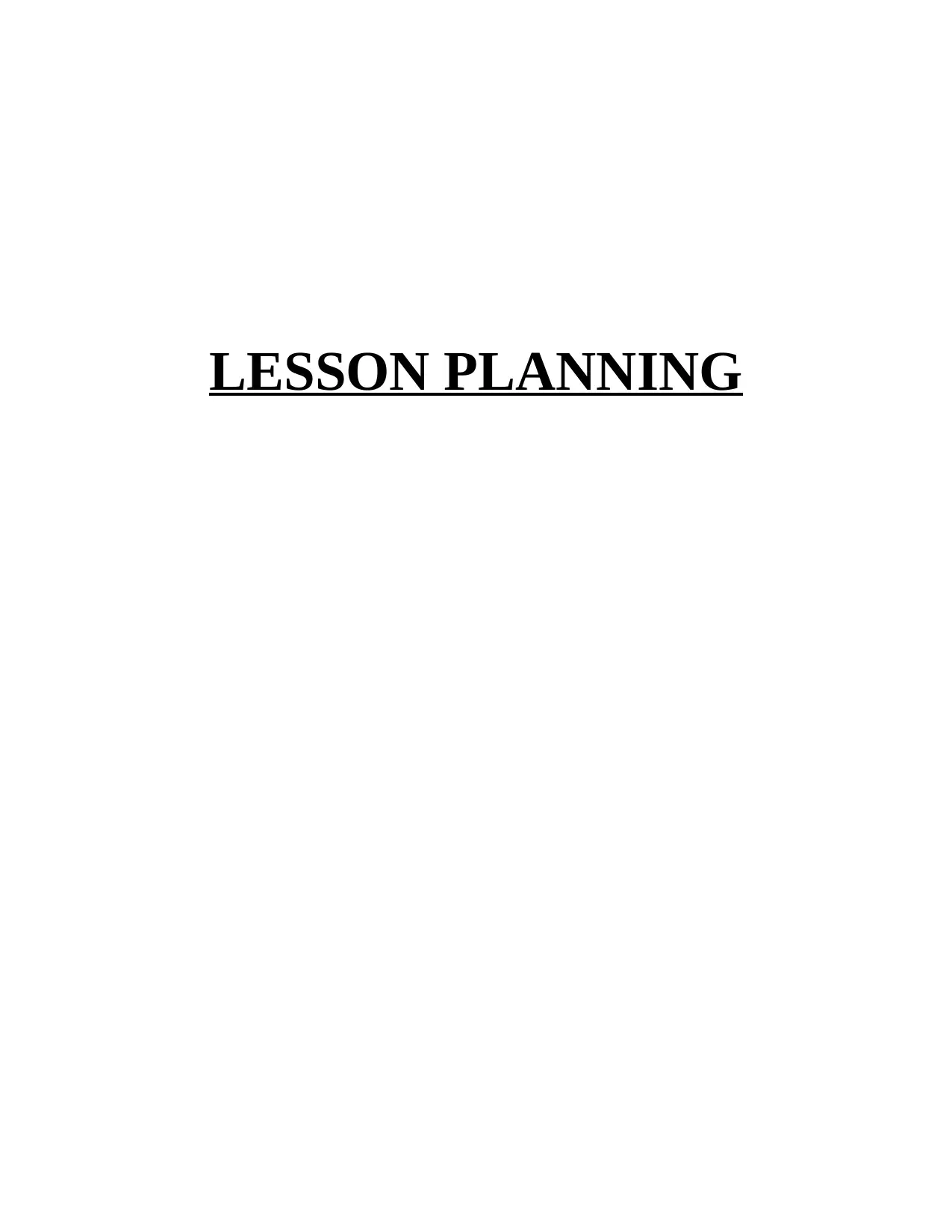
LESSON PLANNING
Paraphrase This Document
Need a fresh take? Get an instant paraphrase of this document with our AI Paraphraser
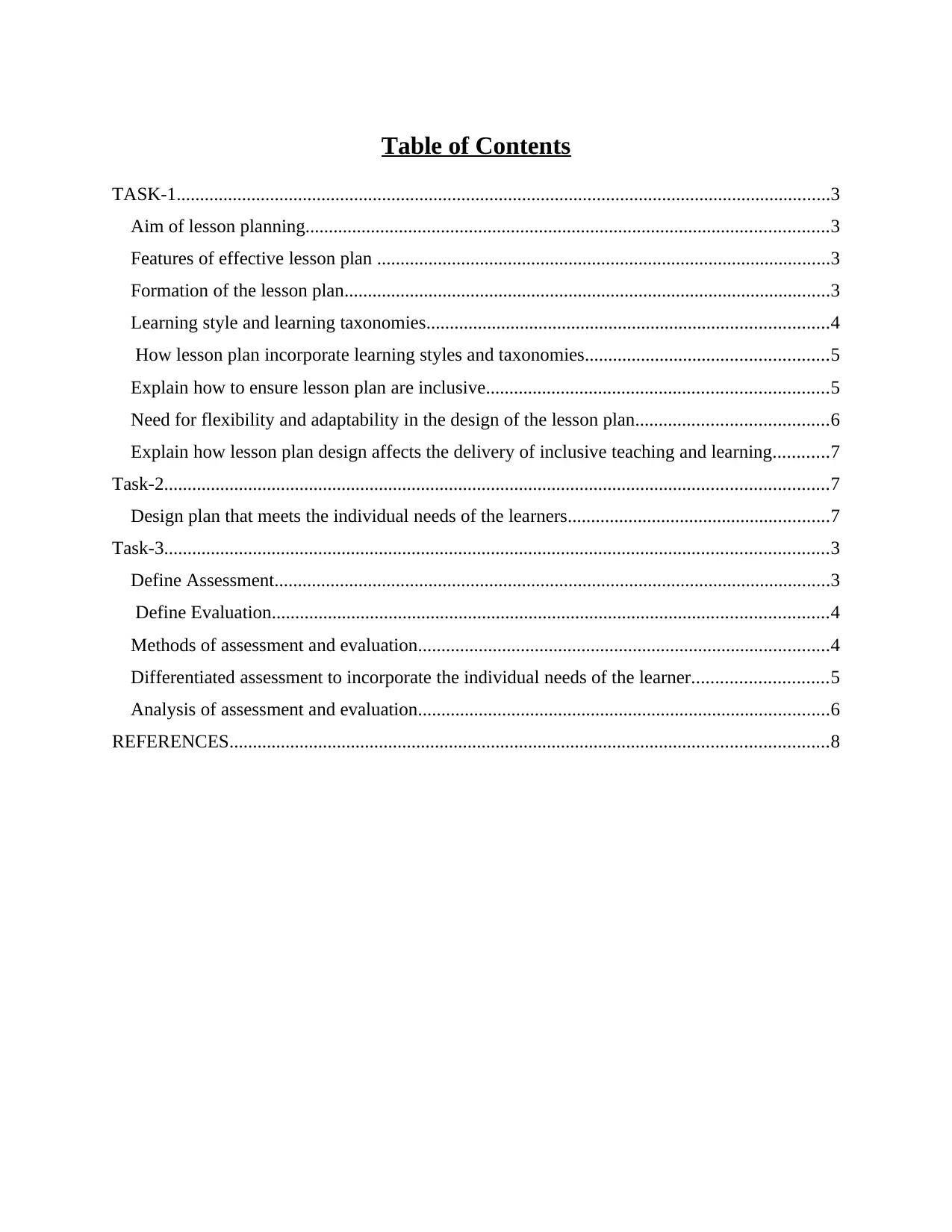
Table of Contents
TASK-1............................................................................................................................................3
Aim of lesson planning................................................................................................................3
Features of effective lesson plan .................................................................................................3
Formation of the lesson plan........................................................................................................3
Learning style and learning taxonomies......................................................................................4
How lesson plan incorporate learning styles and taxonomies....................................................5
Explain how to ensure lesson plan are inclusive.........................................................................5
Need for flexibility and adaptability in the design of the lesson plan.........................................6
Explain how lesson plan design affects the delivery of inclusive teaching and learning............7
Task-2..............................................................................................................................................7
Design plan that meets the individual needs of the learners........................................................7
Task-3..............................................................................................................................................3
Define Assessment.......................................................................................................................3
Define Evaluation.......................................................................................................................4
Methods of assessment and evaluation........................................................................................4
Differentiated assessment to incorporate the individual needs of the learner.............................5
Analysis of assessment and evaluation........................................................................................6
REFERENCES................................................................................................................................8
TASK-1............................................................................................................................................3
Aim of lesson planning................................................................................................................3
Features of effective lesson plan .................................................................................................3
Formation of the lesson plan........................................................................................................3
Learning style and learning taxonomies......................................................................................4
How lesson plan incorporate learning styles and taxonomies....................................................5
Explain how to ensure lesson plan are inclusive.........................................................................5
Need for flexibility and adaptability in the design of the lesson plan.........................................6
Explain how lesson plan design affects the delivery of inclusive teaching and learning............7
Task-2..............................................................................................................................................7
Design plan that meets the individual needs of the learners........................................................7
Task-3..............................................................................................................................................3
Define Assessment.......................................................................................................................3
Define Evaluation.......................................................................................................................4
Methods of assessment and evaluation........................................................................................4
Differentiated assessment to incorporate the individual needs of the learner.............................5
Analysis of assessment and evaluation........................................................................................6
REFERENCES................................................................................................................................8
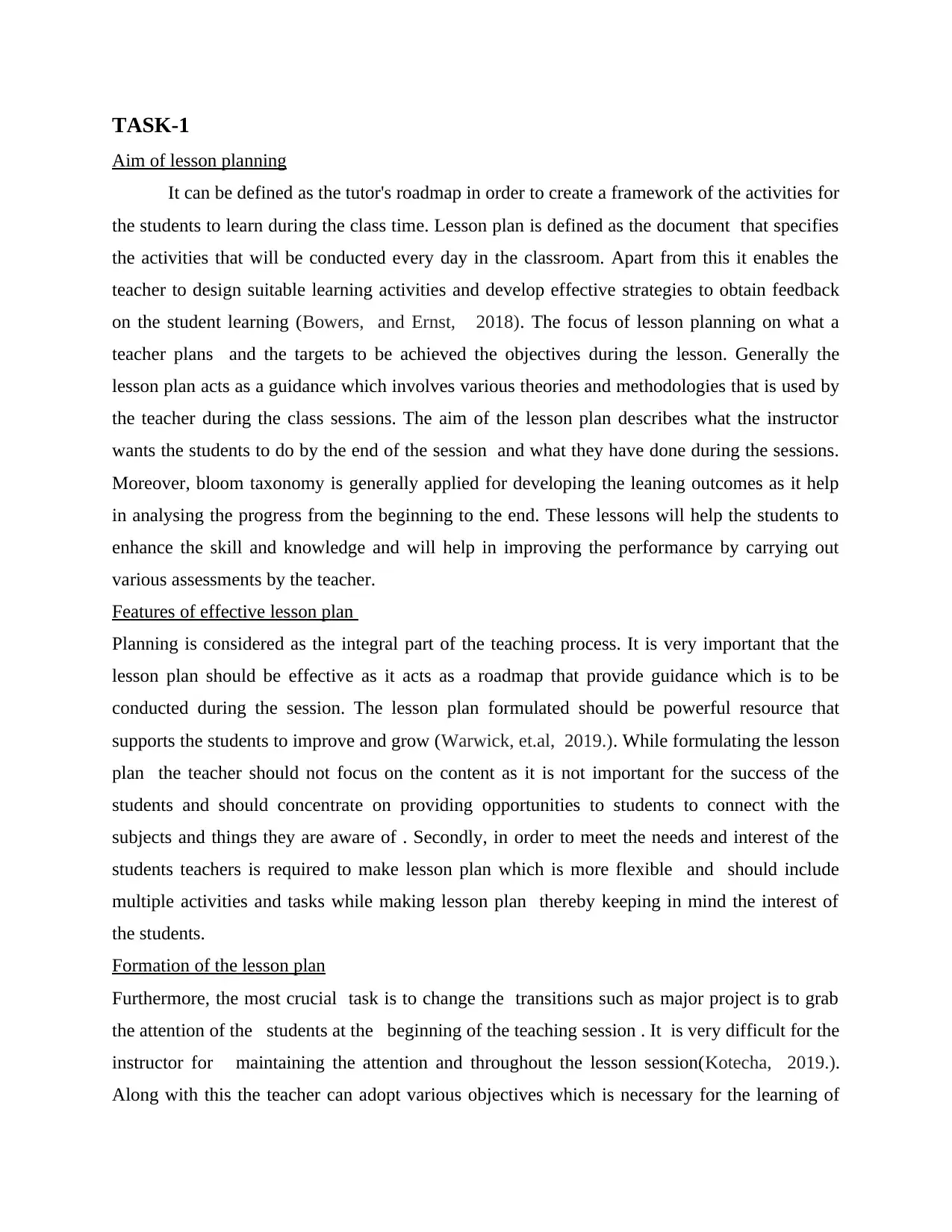
TASK-1
Aim of lesson planning
It can be defined as the tutor's roadmap in order to create a framework of the activities for
the students to learn during the class time. Lesson plan is defined as the document that specifies
the activities that will be conducted every day in the classroom. Apart from this it enables the
teacher to design suitable learning activities and develop effective strategies to obtain feedback
on the student learning (Bowers, and Ernst, 2018). The focus of lesson planning on what a
teacher plans and the targets to be achieved the objectives during the lesson. Generally the
lesson plan acts as a guidance which involves various theories and methodologies that is used by
the teacher during the class sessions. The aim of the lesson plan describes what the instructor
wants the students to do by the end of the session and what they have done during the sessions.
Moreover, bloom taxonomy is generally applied for developing the leaning outcomes as it help
in analysing the progress from the beginning to the end. These lessons will help the students to
enhance the skill and knowledge and will help in improving the performance by carrying out
various assessments by the teacher.
Features of effective lesson plan
Planning is considered as the integral part of the teaching process. It is very important that the
lesson plan should be effective as it acts as a roadmap that provide guidance which is to be
conducted during the session. The lesson plan formulated should be powerful resource that
supports the students to improve and grow (Warwick, et.al, 2019.). While formulating the lesson
plan the teacher should not focus on the content as it is not important for the success of the
students and should concentrate on providing opportunities to students to connect with the
subjects and things they are aware of . Secondly, in order to meet the needs and interest of the
students teachers is required to make lesson plan which is more flexible and should include
multiple activities and tasks while making lesson plan thereby keeping in mind the interest of
the students.
Formation of the lesson plan
Furthermore, the most crucial task is to change the transitions such as major project is to grab
the attention of the students at the beginning of the teaching session . It is very difficult for the
instructor for maintaining the attention and throughout the lesson session(Kotecha, 2019.).
Along with this the teacher can adopt various objectives which is necessary for the learning of
Aim of lesson planning
It can be defined as the tutor's roadmap in order to create a framework of the activities for
the students to learn during the class time. Lesson plan is defined as the document that specifies
the activities that will be conducted every day in the classroom. Apart from this it enables the
teacher to design suitable learning activities and develop effective strategies to obtain feedback
on the student learning (Bowers, and Ernst, 2018). The focus of lesson planning on what a
teacher plans and the targets to be achieved the objectives during the lesson. Generally the
lesson plan acts as a guidance which involves various theories and methodologies that is used by
the teacher during the class sessions. The aim of the lesson plan describes what the instructor
wants the students to do by the end of the session and what they have done during the sessions.
Moreover, bloom taxonomy is generally applied for developing the leaning outcomes as it help
in analysing the progress from the beginning to the end. These lessons will help the students to
enhance the skill and knowledge and will help in improving the performance by carrying out
various assessments by the teacher.
Features of effective lesson plan
Planning is considered as the integral part of the teaching process. It is very important that the
lesson plan should be effective as it acts as a roadmap that provide guidance which is to be
conducted during the session. The lesson plan formulated should be powerful resource that
supports the students to improve and grow (Warwick, et.al, 2019.). While formulating the lesson
plan the teacher should not focus on the content as it is not important for the success of the
students and should concentrate on providing opportunities to students to connect with the
subjects and things they are aware of . Secondly, in order to meet the needs and interest of the
students teachers is required to make lesson plan which is more flexible and should include
multiple activities and tasks while making lesson plan thereby keeping in mind the interest of
the students.
Formation of the lesson plan
Furthermore, the most crucial task is to change the transitions such as major project is to grab
the attention of the students at the beginning of the teaching session . It is very difficult for the
instructor for maintaining the attention and throughout the lesson session(Kotecha, 2019.).
Along with this the teacher can adopt various objectives which is necessary for the learning of
⊘ This is a preview!⊘
Do you want full access?
Subscribe today to unlock all pages.

Trusted by 1+ million students worldwide
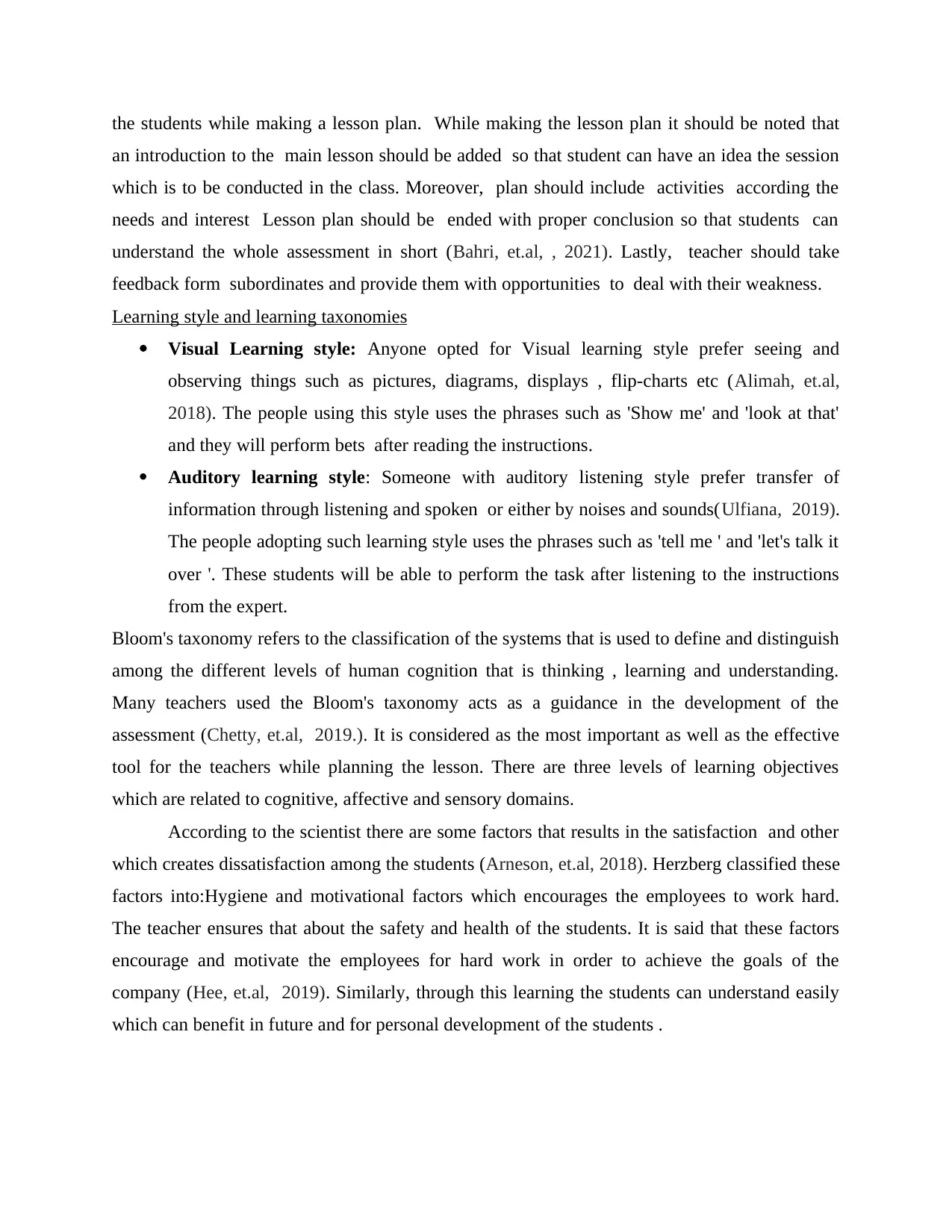
the students while making a lesson plan. While making the lesson plan it should be noted that
an introduction to the main lesson should be added so that student can have an idea the session
which is to be conducted in the class. Moreover, plan should include activities according the
needs and interest Lesson plan should be ended with proper conclusion so that students can
understand the whole assessment in short (Bahri, et.al, , 2021). Lastly, teacher should take
feedback form subordinates and provide them with opportunities to deal with their weakness.
Learning style and learning taxonomies
Visual Learning style: Anyone opted for Visual learning style prefer seeing and
observing things such as pictures, diagrams, displays , flip-charts etc (Alimah, et.al,
2018). The people using this style uses the phrases such as 'Show me' and 'look at that'
and they will perform bets after reading the instructions.
Auditory learning style: Someone with auditory listening style prefer transfer of
information through listening and spoken or either by noises and sounds(Ulfiana, 2019).
The people adopting such learning style uses the phrases such as 'tell me ' and 'let's talk it
over '. These students will be able to perform the task after listening to the instructions
from the expert.
Bloom's taxonomy refers to the classification of the systems that is used to define and distinguish
among the different levels of human cognition that is thinking , learning and understanding.
Many teachers used the Bloom's taxonomy acts as a guidance in the development of the
assessment (Chetty, et.al, 2019.). It is considered as the most important as well as the effective
tool for the teachers while planning the lesson. There are three levels of learning objectives
which are related to cognitive, affective and sensory domains.
According to the scientist there are some factors that results in the satisfaction and other
which creates dissatisfaction among the students (Arneson, et.al, 2018). Herzberg classified these
factors into:Hygiene and motivational factors which encourages the employees to work hard.
The teacher ensures that about the safety and health of the students. It is said that these factors
encourage and motivate the employees for hard work in order to achieve the goals of the
company (Hee, et.al, 2019). Similarly, through this learning the students can understand easily
which can benefit in future and for personal development of the students .
an introduction to the main lesson should be added so that student can have an idea the session
which is to be conducted in the class. Moreover, plan should include activities according the
needs and interest Lesson plan should be ended with proper conclusion so that students can
understand the whole assessment in short (Bahri, et.al, , 2021). Lastly, teacher should take
feedback form subordinates and provide them with opportunities to deal with their weakness.
Learning style and learning taxonomies
Visual Learning style: Anyone opted for Visual learning style prefer seeing and
observing things such as pictures, diagrams, displays , flip-charts etc (Alimah, et.al,
2018). The people using this style uses the phrases such as 'Show me' and 'look at that'
and they will perform bets after reading the instructions.
Auditory learning style: Someone with auditory listening style prefer transfer of
information through listening and spoken or either by noises and sounds(Ulfiana, 2019).
The people adopting such learning style uses the phrases such as 'tell me ' and 'let's talk it
over '. These students will be able to perform the task after listening to the instructions
from the expert.
Bloom's taxonomy refers to the classification of the systems that is used to define and distinguish
among the different levels of human cognition that is thinking , learning and understanding.
Many teachers used the Bloom's taxonomy acts as a guidance in the development of the
assessment (Chetty, et.al, 2019.). It is considered as the most important as well as the effective
tool for the teachers while planning the lesson. There are three levels of learning objectives
which are related to cognitive, affective and sensory domains.
According to the scientist there are some factors that results in the satisfaction and other
which creates dissatisfaction among the students (Arneson, et.al, 2018). Herzberg classified these
factors into:Hygiene and motivational factors which encourages the employees to work hard.
The teacher ensures that about the safety and health of the students. It is said that these factors
encourage and motivate the employees for hard work in order to achieve the goals of the
company (Hee, et.al, 2019). Similarly, through this learning the students can understand easily
which can benefit in future and for personal development of the students .
Paraphrase This Document
Need a fresh take? Get an instant paraphrase of this document with our AI Paraphraser
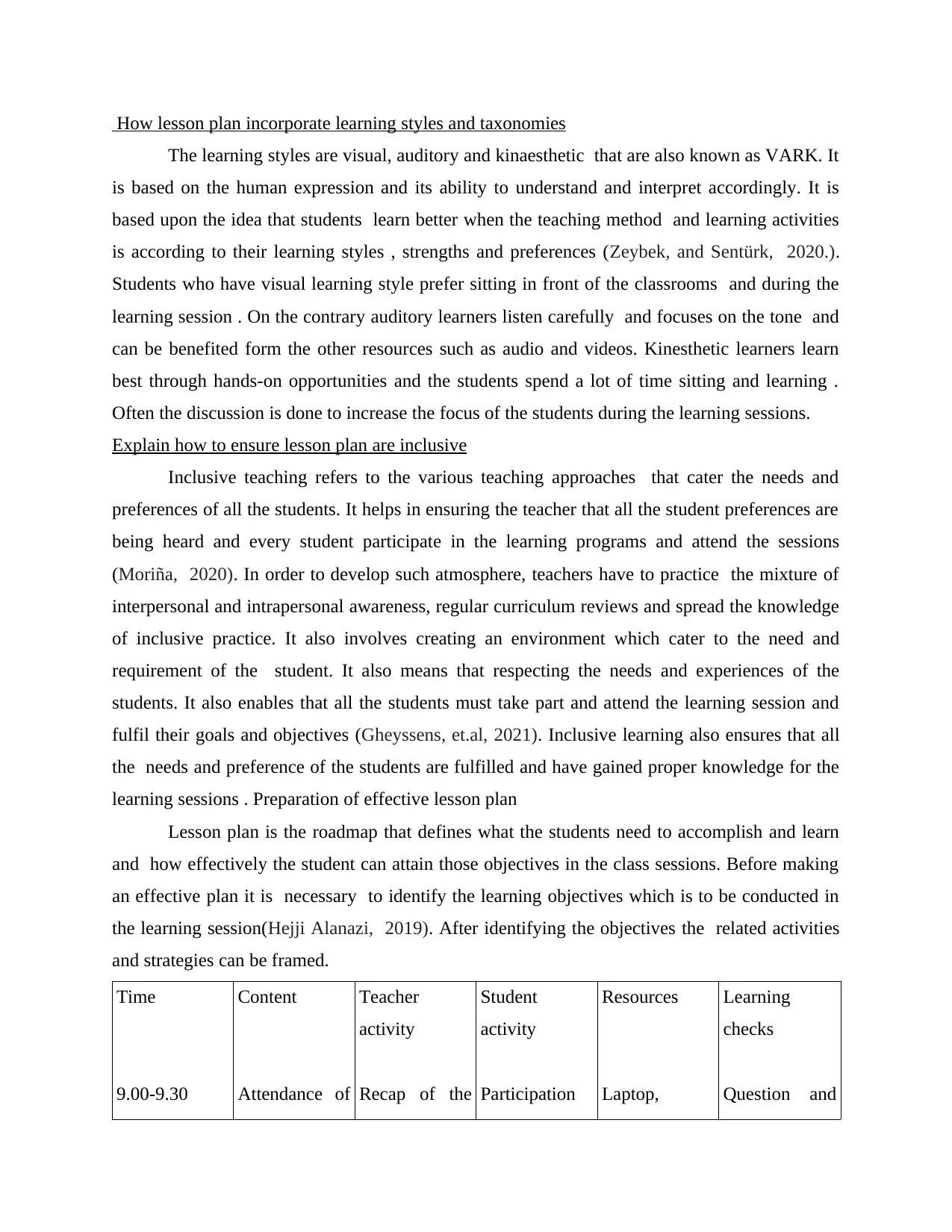
How lesson plan incorporate learning styles and taxonomies
The learning styles are visual, auditory and kinaesthetic that are also known as VARK. It
is based on the human expression and its ability to understand and interpret accordingly. It is
based upon the idea that students learn better when the teaching method and learning activities
is according to their learning styles , strengths and preferences (Zeybek, and Sentürk, 2020.).
Students who have visual learning style prefer sitting in front of the classrooms and during the
learning session . On the contrary auditory learners listen carefully and focuses on the tone and
can be benefited form the other resources such as audio and videos. Kinesthetic learners learn
best through hands-on opportunities and the students spend a lot of time sitting and learning .
Often the discussion is done to increase the focus of the students during the learning sessions.
Explain how to ensure lesson plan are inclusive
Inclusive teaching refers to the various teaching approaches that cater the needs and
preferences of all the students. It helps in ensuring the teacher that all the student preferences are
being heard and every student participate in the learning programs and attend the sessions
(Moriña, 2020). In order to develop such atmosphere, teachers have to practice the mixture of
interpersonal and intrapersonal awareness, regular curriculum reviews and spread the knowledge
of inclusive practice. It also involves creating an environment which cater to the need and
requirement of the student. It also means that respecting the needs and experiences of the
students. It also enables that all the students must take part and attend the learning session and
fulfil their goals and objectives (Gheyssens, et.al, 2021). Inclusive learning also ensures that all
the needs and preference of the students are fulfilled and have gained proper knowledge for the
learning sessions . Preparation of effective lesson plan
Lesson plan is the roadmap that defines what the students need to accomplish and learn
and how effectively the student can attain those objectives in the class sessions. Before making
an effective plan it is necessary to identify the learning objectives which is to be conducted in
the learning session(Hejji Alanazi, 2019). After identifying the objectives the related activities
and strategies can be framed.
Time
9.00-9.30
Content
Attendance of
Teacher
activity
Recap of the
Student
activity
Participation
Resources
Laptop,
Learning
checks
Question and
The learning styles are visual, auditory and kinaesthetic that are also known as VARK. It
is based on the human expression and its ability to understand and interpret accordingly. It is
based upon the idea that students learn better when the teaching method and learning activities
is according to their learning styles , strengths and preferences (Zeybek, and Sentürk, 2020.).
Students who have visual learning style prefer sitting in front of the classrooms and during the
learning session . On the contrary auditory learners listen carefully and focuses on the tone and
can be benefited form the other resources such as audio and videos. Kinesthetic learners learn
best through hands-on opportunities and the students spend a lot of time sitting and learning .
Often the discussion is done to increase the focus of the students during the learning sessions.
Explain how to ensure lesson plan are inclusive
Inclusive teaching refers to the various teaching approaches that cater the needs and
preferences of all the students. It helps in ensuring the teacher that all the student preferences are
being heard and every student participate in the learning programs and attend the sessions
(Moriña, 2020). In order to develop such atmosphere, teachers have to practice the mixture of
interpersonal and intrapersonal awareness, regular curriculum reviews and spread the knowledge
of inclusive practice. It also involves creating an environment which cater to the need and
requirement of the student. It also means that respecting the needs and experiences of the
students. It also enables that all the students must take part and attend the learning session and
fulfil their goals and objectives (Gheyssens, et.al, 2021). Inclusive learning also ensures that all
the needs and preference of the students are fulfilled and have gained proper knowledge for the
learning sessions . Preparation of effective lesson plan
Lesson plan is the roadmap that defines what the students need to accomplish and learn
and how effectively the student can attain those objectives in the class sessions. Before making
an effective plan it is necessary to identify the learning objectives which is to be conducted in
the learning session(Hejji Alanazi, 2019). After identifying the objectives the related activities
and strategies can be framed.
Time
9.00-9.30
Content
Attendance of
Teacher
activity
Recap of the
Student
activity
Participation
Resources
Laptop,
Learning
checks
Question and
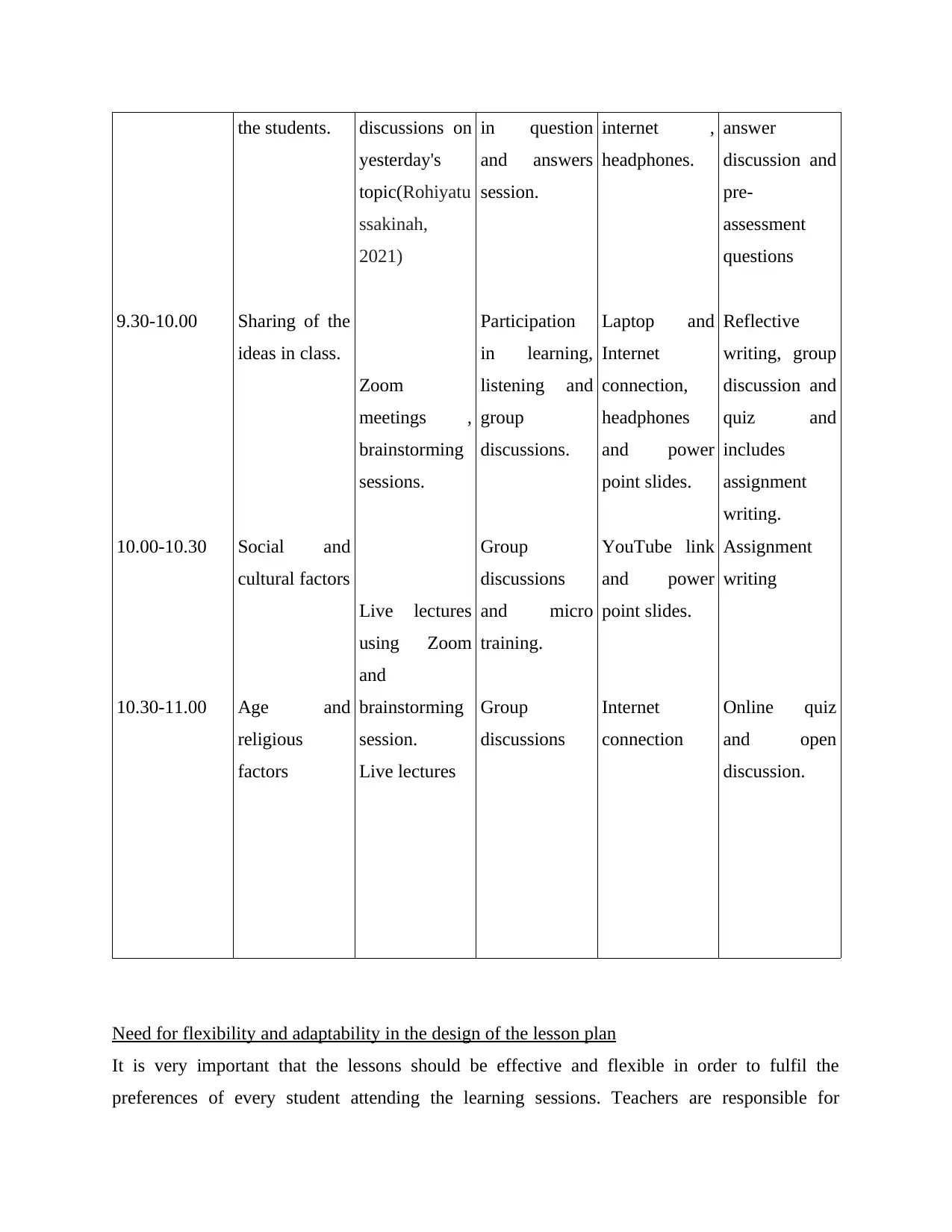
9.30-10.00
10.00-10.30
10.30-11.00
the students.
Sharing of the
ideas in class.
Social and
cultural factors
Age and
religious
factors
discussions on
yesterday's
topic(Rohiyatu
ssakinah,
2021)
Zoom
meetings ,
brainstorming
sessions.
Live lectures
using Zoom
and
brainstorming
session.
Live lectures
in question
and answers
session.
Participation
in learning,
listening and
group
discussions.
Group
discussions
and micro
training.
Group
discussions
internet ,
headphones.
Laptop and
Internet
connection,
headphones
and power
point slides.
YouTube link
and power
point slides.
Internet
connection
answer
discussion and
pre-
assessment
questions
Reflective
writing, group
discussion and
quiz and
includes
assignment
writing.
Assignment
writing
Online quiz
and open
discussion.
Need for flexibility and adaptability in the design of the lesson plan
It is very important that the lessons should be effective and flexible in order to fulfil the
preferences of every student attending the learning sessions. Teachers are responsible for
10.00-10.30
10.30-11.00
the students.
Sharing of the
ideas in class.
Social and
cultural factors
Age and
religious
factors
discussions on
yesterday's
topic(Rohiyatu
ssakinah,
2021)
Zoom
meetings ,
brainstorming
sessions.
Live lectures
using Zoom
and
brainstorming
session.
Live lectures
in question
and answers
session.
Participation
in learning,
listening and
group
discussions.
Group
discussions
and micro
training.
Group
discussions
internet ,
headphones.
Laptop and
Internet
connection,
headphones
and power
point slides.
YouTube link
and power
point slides.
Internet
connection
answer
discussion and
pre-
assessment
questions
Reflective
writing, group
discussion and
quiz and
includes
assignment
writing.
Assignment
writing
Online quiz
and open
discussion.
Need for flexibility and adaptability in the design of the lesson plan
It is very important that the lessons should be effective and flexible in order to fulfil the
preferences of every student attending the learning sessions. Teachers are responsible for
⊘ This is a preview!⊘
Do you want full access?
Subscribe today to unlock all pages.

Trusted by 1+ million students worldwide
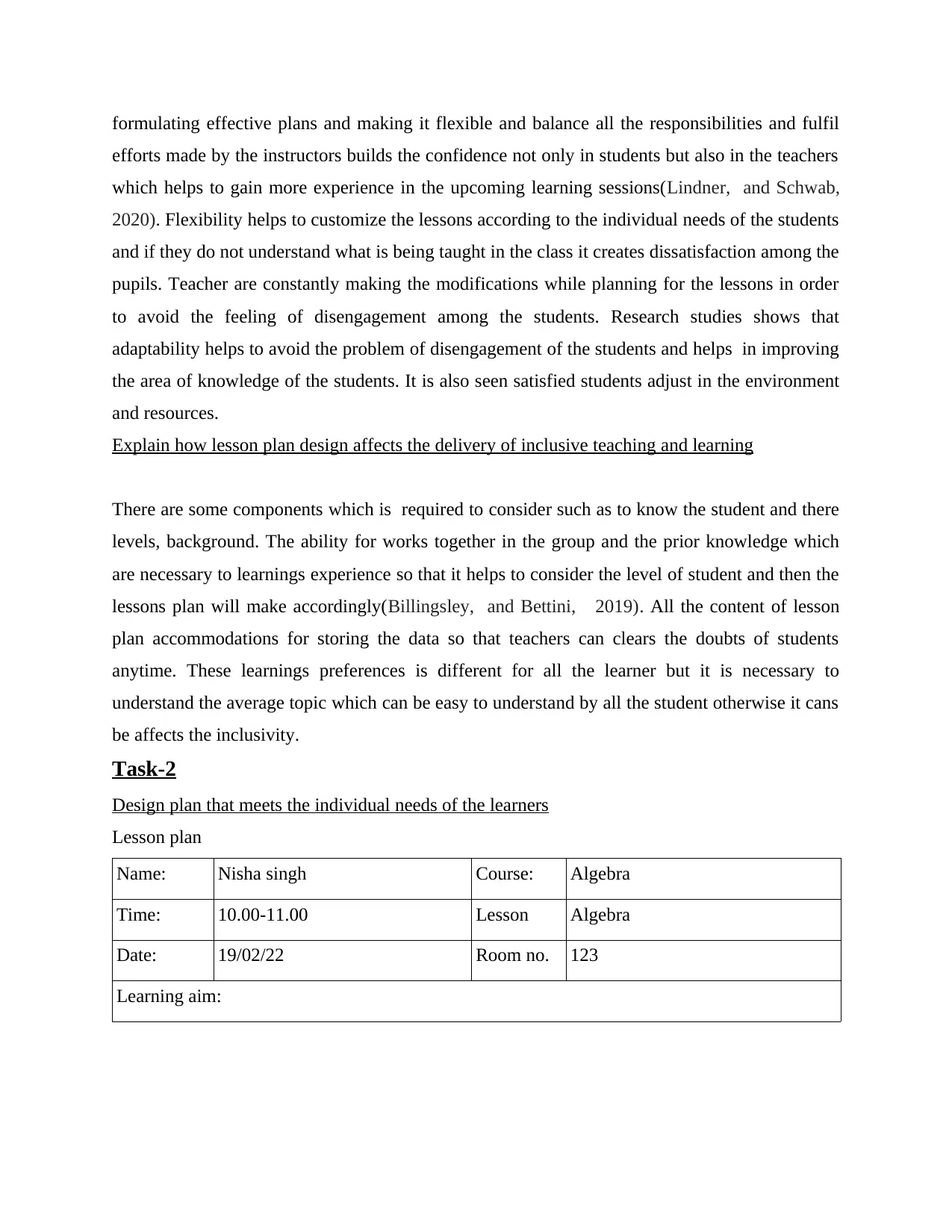
formulating effective plans and making it flexible and balance all the responsibilities and fulfil
efforts made by the instructors builds the confidence not only in students but also in the teachers
which helps to gain more experience in the upcoming learning sessions(Lindner, and Schwab,
2020). Flexibility helps to customize the lessons according to the individual needs of the students
and if they do not understand what is being taught in the class it creates dissatisfaction among the
pupils. Teacher are constantly making the modifications while planning for the lessons in order
to avoid the feeling of disengagement among the students. Research studies shows that
adaptability helps to avoid the problem of disengagement of the students and helps in improving
the area of knowledge of the students. It is also seen satisfied students adjust in the environment
and resources.
Explain how lesson plan design affects the delivery of inclusive teaching and learning
There are some components which is required to consider such as to know the student and there
levels, background. The ability for works together in the group and the prior knowledge which
are necessary to learnings experience so that it helps to consider the level of student and then the
lessons plan will make accordingly(Billingsley, and Bettini, 2019). All the content of lesson
plan accommodations for storing the data so that teachers can clears the doubts of students
anytime. These learnings preferences is different for all the learner but it is necessary to
understand the average topic which can be easy to understand by all the student otherwise it cans
be affects the inclusivity.
Task-2
Design plan that meets the individual needs of the learners
Lesson plan
Name: Nisha singh Course: Algebra
Time: 10.00-11.00 Lesson Algebra
Date: 19/02/22 Room no. 123
Learning aim:
efforts made by the instructors builds the confidence not only in students but also in the teachers
which helps to gain more experience in the upcoming learning sessions(Lindner, and Schwab,
2020). Flexibility helps to customize the lessons according to the individual needs of the students
and if they do not understand what is being taught in the class it creates dissatisfaction among the
pupils. Teacher are constantly making the modifications while planning for the lessons in order
to avoid the feeling of disengagement among the students. Research studies shows that
adaptability helps to avoid the problem of disengagement of the students and helps in improving
the area of knowledge of the students. It is also seen satisfied students adjust in the environment
and resources.
Explain how lesson plan design affects the delivery of inclusive teaching and learning
There are some components which is required to consider such as to know the student and there
levels, background. The ability for works together in the group and the prior knowledge which
are necessary to learnings experience so that it helps to consider the level of student and then the
lessons plan will make accordingly(Billingsley, and Bettini, 2019). All the content of lesson
plan accommodations for storing the data so that teachers can clears the doubts of students
anytime. These learnings preferences is different for all the learner but it is necessary to
understand the average topic which can be easy to understand by all the student otherwise it cans
be affects the inclusivity.
Task-2
Design plan that meets the individual needs of the learners
Lesson plan
Name: Nisha singh Course: Algebra
Time: 10.00-11.00 Lesson Algebra
Date: 19/02/22 Room no. 123
Learning aim:
Paraphrase This Document
Need a fresh take? Get an instant paraphrase of this document with our AI Paraphraser
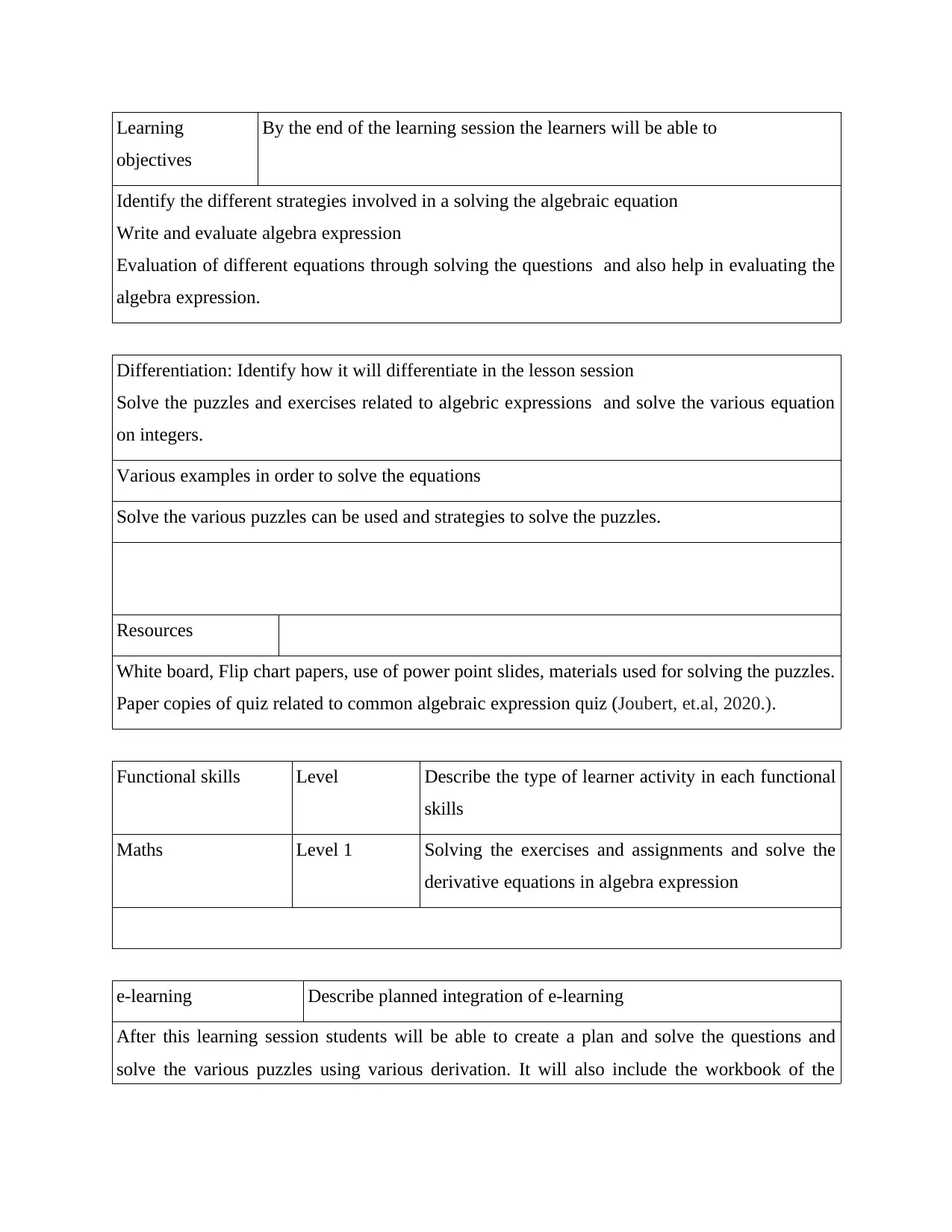
Learning
objectives
By the end of the learning session the learners will be able to
Identify the different strategies involved in a solving the algebraic equation
Write and evaluate algebra expression
Evaluation of different equations through solving the questions and also help in evaluating the
algebra expression.
Differentiation: Identify how it will differentiate in the lesson session
Solve the puzzles and exercises related to algebric expressions and solve the various equation
on integers.
Various examples in order to solve the equations
Solve the various puzzles can be used and strategies to solve the puzzles.
Resources
White board, Flip chart papers, use of power point slides, materials used for solving the puzzles.
Paper copies of quiz related to common algebraic expression quiz (Joubert, et.al, 2020.).
Functional skills Level Describe the type of learner activity in each functional
skills
Maths Level 1 Solving the exercises and assignments and solve the
derivative equations in algebra expression
e-learning Describe planned integration of e-learning
After this learning session students will be able to create a plan and solve the questions and
solve the various puzzles using various derivation. It will also include the workbook of the
objectives
By the end of the learning session the learners will be able to
Identify the different strategies involved in a solving the algebraic equation
Write and evaluate algebra expression
Evaluation of different equations through solving the questions and also help in evaluating the
algebra expression.
Differentiation: Identify how it will differentiate in the lesson session
Solve the puzzles and exercises related to algebric expressions and solve the various equation
on integers.
Various examples in order to solve the equations
Solve the various puzzles can be used and strategies to solve the puzzles.
Resources
White board, Flip chart papers, use of power point slides, materials used for solving the puzzles.
Paper copies of quiz related to common algebraic expression quiz (Joubert, et.al, 2020.).
Functional skills Level Describe the type of learner activity in each functional
skills
Maths Level 1 Solving the exercises and assignments and solve the
derivative equations in algebra expression
e-learning Describe planned integration of e-learning
After this learning session students will be able to create a plan and solve the questions and
solve the various puzzles using various derivation. It will also include the workbook of the
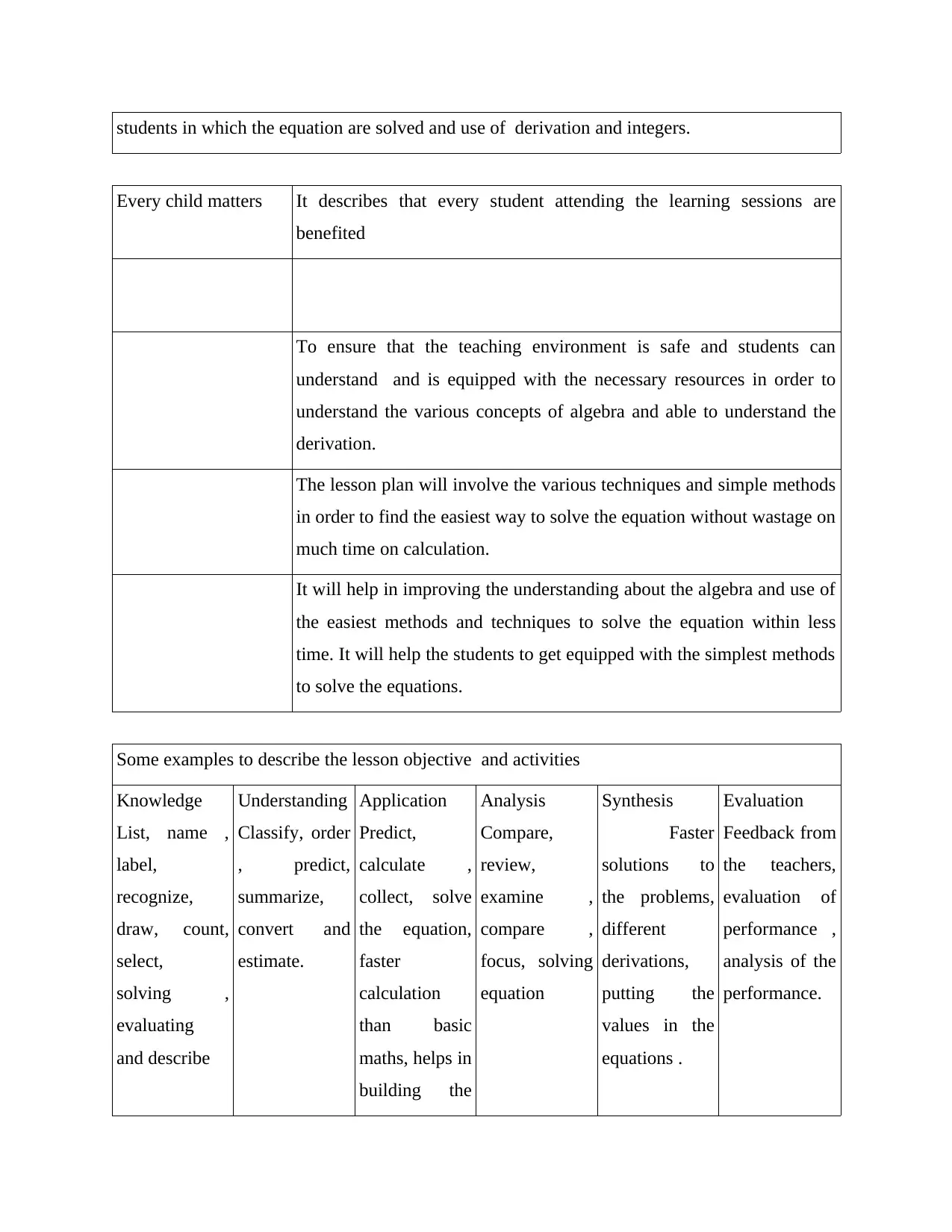
students in which the equation are solved and use of derivation and integers.
Every child matters It describes that every student attending the learning sessions are
benefited
To ensure that the teaching environment is safe and students can
understand and is equipped with the necessary resources in order to
understand the various concepts of algebra and able to understand the
derivation.
The lesson plan will involve the various techniques and simple methods
in order to find the easiest way to solve the equation without wastage on
much time on calculation.
It will help in improving the understanding about the algebra and use of
the easiest methods and techniques to solve the equation within less
time. It will help the students to get equipped with the simplest methods
to solve the equations.
Some examples to describe the lesson objective and activities
Knowledge
List, name ,
label,
recognize,
draw, count,
select,
solving ,
evaluating
and describe
Understanding
Classify, order
, predict,
summarize,
convert and
estimate.
Application
Predict,
calculate ,
collect, solve
the equation,
faster
calculation
than basic
maths, helps in
building the
Analysis
Compare,
review,
examine ,
compare ,
focus, solving
equation
Synthesis
Faster
solutions to
the problems,
different
derivations,
putting the
values in the
equations .
Evaluation
Feedback from
the teachers,
evaluation of
performance ,
analysis of the
performance.
Every child matters It describes that every student attending the learning sessions are
benefited
To ensure that the teaching environment is safe and students can
understand and is equipped with the necessary resources in order to
understand the various concepts of algebra and able to understand the
derivation.
The lesson plan will involve the various techniques and simple methods
in order to find the easiest way to solve the equation without wastage on
much time on calculation.
It will help in improving the understanding about the algebra and use of
the easiest methods and techniques to solve the equation within less
time. It will help the students to get equipped with the simplest methods
to solve the equations.
Some examples to describe the lesson objective and activities
Knowledge
List, name ,
label,
recognize,
draw, count,
select,
solving ,
evaluating
and describe
Understanding
Classify, order
, predict,
summarize,
convert and
estimate.
Application
Predict,
calculate ,
collect, solve
the equation,
faster
calculation
than basic
maths, helps in
building the
Analysis
Compare,
review,
examine ,
compare ,
focus, solving
equation
Synthesis
Faster
solutions to
the problems,
different
derivations,
putting the
values in the
equations .
Evaluation
Feedback from
the teachers,
evaluation of
performance ,
analysis of the
performance.
⊘ This is a preview!⊘
Do you want full access?
Subscribe today to unlock all pages.

Trusted by 1+ million students worldwide

knowledge
about statistics
about statistics
Paraphrase This Document
Need a fresh take? Get an instant paraphrase of this document with our AI Paraphraser
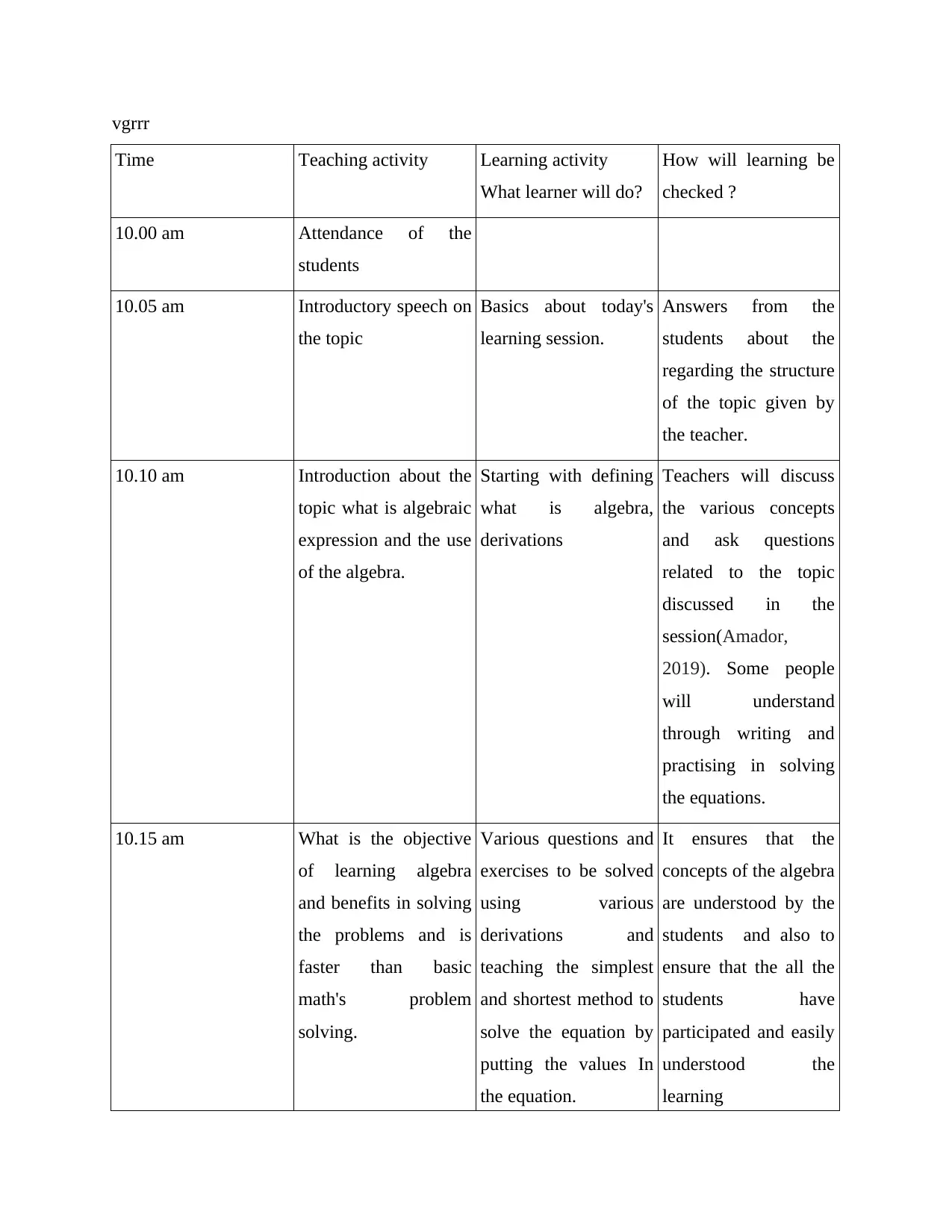
vgrrr
Time Teaching activity Learning activity
What learner will do?
How will learning be
checked ?
10.00 am Attendance of the
students
10.05 am Introductory speech on
the topic
Basics about today's
learning session.
Answers from the
students about the
regarding the structure
of the topic given by
the teacher.
10.10 am Introduction about the
topic what is algebraic
expression and the use
of the algebra.
Starting with defining
what is algebra,
derivations
Teachers will discuss
the various concepts
and ask questions
related to the topic
discussed in the
session(Amador,
2019). Some people
will understand
through writing and
practising in solving
the equations.
10.15 am What is the objective
of learning algebra
and benefits in solving
the problems and is
faster than basic
math's problem
solving.
Various questions and
exercises to be solved
using various
derivations and
teaching the simplest
and shortest method to
solve the equation by
putting the values In
the equation.
It ensures that the
concepts of the algebra
are understood by the
students and also to
ensure that the all the
students have
participated and easily
understood the
learning
Time Teaching activity Learning activity
What learner will do?
How will learning be
checked ?
10.00 am Attendance of the
students
10.05 am Introductory speech on
the topic
Basics about today's
learning session.
Answers from the
students about the
regarding the structure
of the topic given by
the teacher.
10.10 am Introduction about the
topic what is algebraic
expression and the use
of the algebra.
Starting with defining
what is algebra,
derivations
Teachers will discuss
the various concepts
and ask questions
related to the topic
discussed in the
session(Amador,
2019). Some people
will understand
through writing and
practising in solving
the equations.
10.15 am What is the objective
of learning algebra
and benefits in solving
the problems and is
faster than basic
math's problem
solving.
Various questions and
exercises to be solved
using various
derivations and
teaching the simplest
and shortest method to
solve the equation by
putting the values In
the equation.
It ensures that the
concepts of the algebra
are understood by the
students and also to
ensure that the all the
students have
participated and easily
understood the
learning
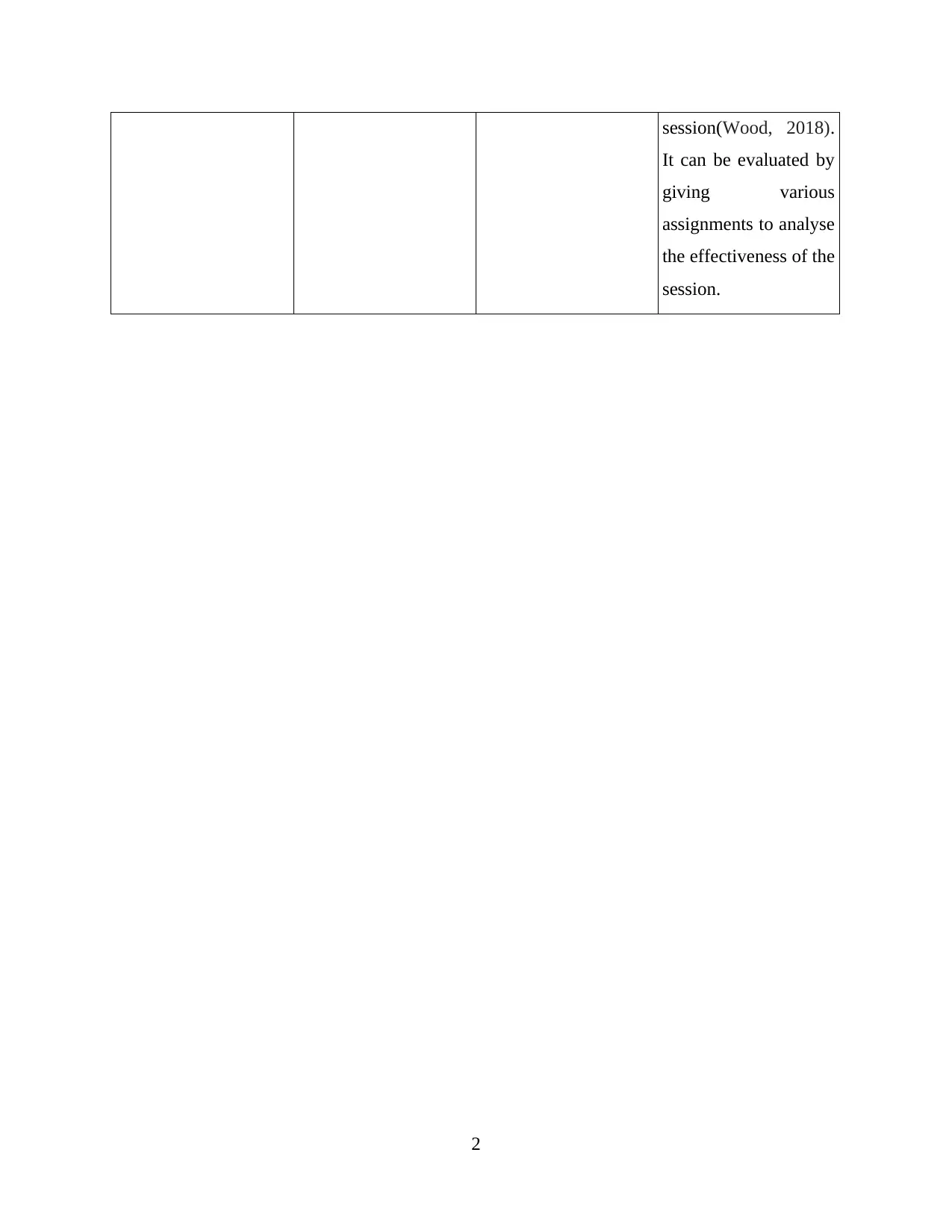
session(Wood, 2018).
It can be evaluated by
giving various
assignments to analyse
the effectiveness of the
session.
2
It can be evaluated by
giving various
assignments to analyse
the effectiveness of the
session.
2
⊘ This is a preview!⊘
Do you want full access?
Subscribe today to unlock all pages.

Trusted by 1+ million students worldwide
1 out of 20
Related Documents
Your All-in-One AI-Powered Toolkit for Academic Success.
+13062052269
info@desklib.com
Available 24*7 on WhatsApp / Email
![[object Object]](/_next/static/media/star-bottom.7253800d.svg)
Unlock your academic potential
Copyright © 2020–2025 A2Z Services. All Rights Reserved. Developed and managed by ZUCOL.



